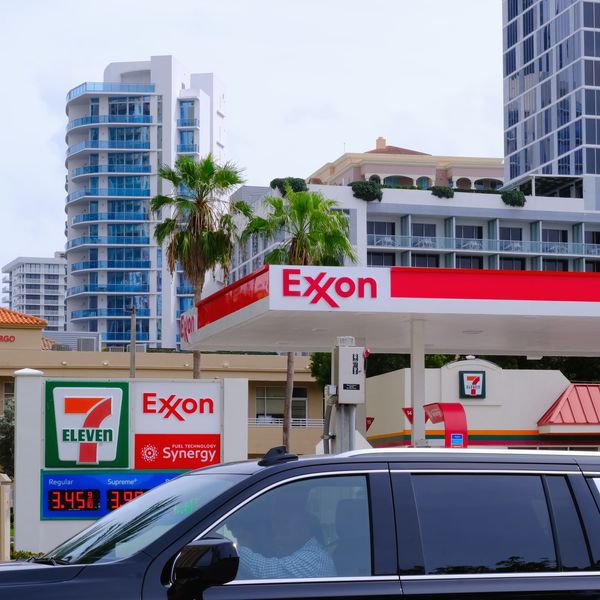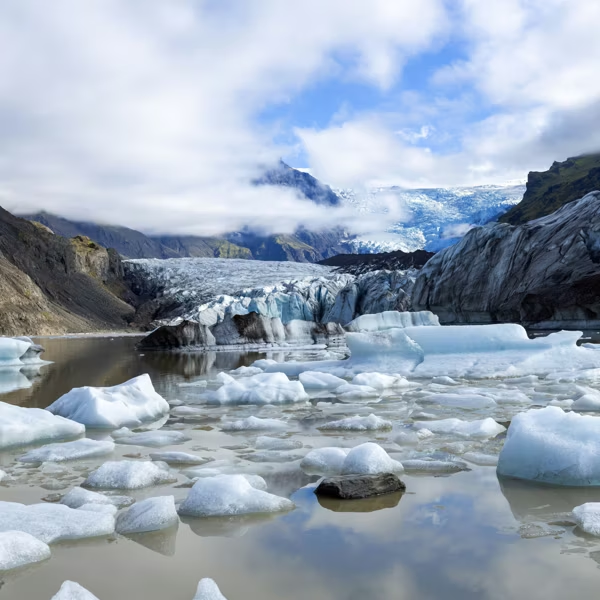
This satellite image shows cloud cover over the Pacific Ocean and the California coast—the infamous "June Gloom"—on June 10, 2013.
False Climate Solution of Geoengineering Could Cause Heatwaves Thousands of Miles Away
"We need more regional geoengineering modeling studies like this work to characterize these unintended side effects before they have a chance to play out in the real world," said the study's lead author.
A study published Friday found that a cloud engineering technique designed to cool parts of the western United States could inadvertently stoke heatwaves from North America to Europe, underscoring why many scientists reject geoengineering as a false climate solution.
The study, published in the journal Nature Climate Change, concludes that marine cloud brightening (MCB)—"a geoengineering proposal to cool atmospheric temperatures and reduce climate change impacts"—in the "remote mid-latitudes or proximate subtropics" of the northern Pacific Ocean—would decrease "the relative risk of dangerous summer heat exposure by 55% and 16%, respectively."
However, the researchers found that regions including Africa's Sahel, central North America, Europe, and northeastern Asia would "experience exacerbated heat stress and hotter summers with MCB than would otherwise occur under global warming."
Additionally, the study shows that MCB would be less effective over time and could "even increase heat stress in the western United States" and beyond by mid-century.
University of California San Diego researcher Jessica Wan, who led the study, told The Guardian that MCB "can be very effective for the U.S. West Coast if done now, but it may be ineffective there in the future and could cause heatwaves in Europe."
The study's authors said the paper's findings are especially troubling given the dearth of international MCB regulation.
"There is really no solar geoengineering governance right now. That is scary," said Wan. "Science and policy need to be developed together. We don't want to be in a situation where one region is forced to do geoengineering to combat what another part of the world has done to respond to droughts and heatwaves."
As New Scientist reported:
The MCB experiments that have taken place so far in Australia and California haven't been of a sufficiently large scale to cause detectable climate effects, but they suggest that regional geoengineering could be closer to reality than previously thought, says Wan. "We need more regional geoengineering modeling studies like this work to characterize these unintended side effects before they have a chance to play out in the real world."
In Australia, researchers are experimenting with geoengineering techniques in an effort to cool the Great Barrier Reef and decelerate its bleaching. In California, scientists from the University of Washington sprayed sea salt flecks over a decommissioned aircraft carrier in the San Francisco Bay in hushed testing that was halted by the city of Alameda last month over safety concerns.
"We strongly welcome Alameda City Council's unanimous decision to say no to the first open-air marine cloud brightening experiment in the U.S.," Mary Church of the Center for International Environmental Law said after the halt. "Key concerns raised by council members focused on lack of sufficient information, notice, and transparency. The rejection rightfully reflects the gravity of what's at stake for both local and global communities."
An Urgent Message From Our Co-Founder
Dear Common Dreams reader, The U.S. is on a fast track to authoritarianism like nothing I've ever seen. Meanwhile, corporate news outlets are utterly capitulating to Trump, twisting their coverage to avoid drawing his ire while lining up to stuff cash in his pockets. That's why I believe that Common Dreams is doing the best and most consequential reporting that we've ever done. Our small but mighty team is a progressive reporting powerhouse, covering the news every day that the corporate media never will. Our mission has always been simple: To inform. To inspire. And to ignite change for the common good. Now here's the key piece that I want all our readers to understand: None of this would be possible without your financial support. That's not just some fundraising cliche. It's the absolute and literal truth. We don't accept corporate advertising and never will. We don't have a paywall because we don't think people should be blocked from critical news based on their ability to pay. Everything we do is funded by the donations of readers like you. Will you donate now to help power the nonprofit, independent reporting of Common Dreams? Thank you for being a vital member of our community. Together, we can keep independent journalism alive when it’s needed most. - Craig Brown, Co-founder |
A study published Friday found that a cloud engineering technique designed to cool parts of the western United States could inadvertently stoke heatwaves from North America to Europe, underscoring why many scientists reject geoengineering as a false climate solution.
The study, published in the journal Nature Climate Change, concludes that marine cloud brightening (MCB)—"a geoengineering proposal to cool atmospheric temperatures and reduce climate change impacts"—in the "remote mid-latitudes or proximate subtropics" of the northern Pacific Ocean—would decrease "the relative risk of dangerous summer heat exposure by 55% and 16%, respectively."
However, the researchers found that regions including Africa's Sahel, central North America, Europe, and northeastern Asia would "experience exacerbated heat stress and hotter summers with MCB than would otherwise occur under global warming."
Additionally, the study shows that MCB would be less effective over time and could "even increase heat stress in the western United States" and beyond by mid-century.
University of California San Diego researcher Jessica Wan, who led the study, told The Guardian that MCB "can be very effective for the U.S. West Coast if done now, but it may be ineffective there in the future and could cause heatwaves in Europe."
The study's authors said the paper's findings are especially troubling given the dearth of international MCB regulation.
"There is really no solar geoengineering governance right now. That is scary," said Wan. "Science and policy need to be developed together. We don't want to be in a situation where one region is forced to do geoengineering to combat what another part of the world has done to respond to droughts and heatwaves."
As New Scientist reported:
The MCB experiments that have taken place so far in Australia and California haven't been of a sufficiently large scale to cause detectable climate effects, but they suggest that regional geoengineering could be closer to reality than previously thought, says Wan. "We need more regional geoengineering modeling studies like this work to characterize these unintended side effects before they have a chance to play out in the real world."
In Australia, researchers are experimenting with geoengineering techniques in an effort to cool the Great Barrier Reef and decelerate its bleaching. In California, scientists from the University of Washington sprayed sea salt flecks over a decommissioned aircraft carrier in the San Francisco Bay in hushed testing that was halted by the city of Alameda last month over safety concerns.
"We strongly welcome Alameda City Council's unanimous decision to say no to the first open-air marine cloud brightening experiment in the U.S.," Mary Church of the Center for International Environmental Law said after the halt. "Key concerns raised by council members focused on lack of sufficient information, notice, and transparency. The rejection rightfully reflects the gravity of what's at stake for both local and global communities."
- Opinion | The Dangerous Politics of Climate Engineering | Common Dreams ›
- 'Geoengineering Fails Again': Coalition Cheers End of Arctic Ice Project | Common Dreams ›
A study published Friday found that a cloud engineering technique designed to cool parts of the western United States could inadvertently stoke heatwaves from North America to Europe, underscoring why many scientists reject geoengineering as a false climate solution.
The study, published in the journal Nature Climate Change, concludes that marine cloud brightening (MCB)—"a geoengineering proposal to cool atmospheric temperatures and reduce climate change impacts"—in the "remote mid-latitudes or proximate subtropics" of the northern Pacific Ocean—would decrease "the relative risk of dangerous summer heat exposure by 55% and 16%, respectively."
However, the researchers found that regions including Africa's Sahel, central North America, Europe, and northeastern Asia would "experience exacerbated heat stress and hotter summers with MCB than would otherwise occur under global warming."
Additionally, the study shows that MCB would be less effective over time and could "even increase heat stress in the western United States" and beyond by mid-century.
University of California San Diego researcher Jessica Wan, who led the study, told The Guardian that MCB "can be very effective for the U.S. West Coast if done now, but it may be ineffective there in the future and could cause heatwaves in Europe."
The study's authors said the paper's findings are especially troubling given the dearth of international MCB regulation.
"There is really no solar geoengineering governance right now. That is scary," said Wan. "Science and policy need to be developed together. We don't want to be in a situation where one region is forced to do geoengineering to combat what another part of the world has done to respond to droughts and heatwaves."
As New Scientist reported:
The MCB experiments that have taken place so far in Australia and California haven't been of a sufficiently large scale to cause detectable climate effects, but they suggest that regional geoengineering could be closer to reality than previously thought, says Wan. "We need more regional geoengineering modeling studies like this work to characterize these unintended side effects before they have a chance to play out in the real world."
In Australia, researchers are experimenting with geoengineering techniques in an effort to cool the Great Barrier Reef and decelerate its bleaching. In California, scientists from the University of Washington sprayed sea salt flecks over a decommissioned aircraft carrier in the San Francisco Bay in hushed testing that was halted by the city of Alameda last month over safety concerns.
"We strongly welcome Alameda City Council's unanimous decision to say no to the first open-air marine cloud brightening experiment in the U.S.," Mary Church of the Center for International Environmental Law said after the halt. "Key concerns raised by council members focused on lack of sufficient information, notice, and transparency. The rejection rightfully reflects the gravity of what's at stake for both local and global communities."
- Opinion | The Dangerous Politics of Climate Engineering | Common Dreams ›
- 'Geoengineering Fails Again': Coalition Cheers End of Arctic Ice Project | Common Dreams ›

